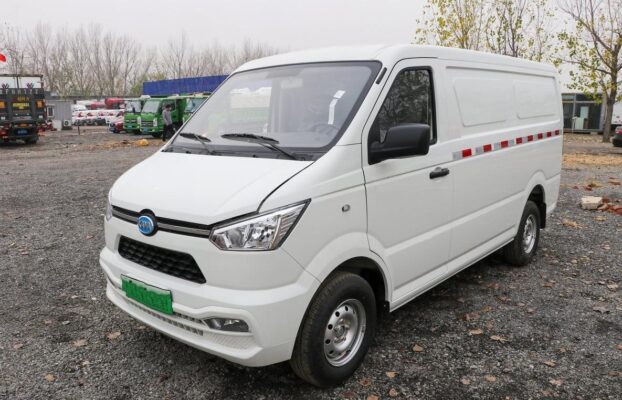Elektrikli yük maşını xəbərləri
Elektrikli Maşınlar Ani Əyləc zamanı Niyə İrəli Edirlər??
When EVs experience sudden braking, the forward lurch can often be attributed to the fundamental differences in their braking and propulsion systems compared to traditional internal combustion engine (ICE) nəqliyyat vasitələri. Here’s a breakdown of the key factors:
1. Regenerative Braking Dynamics
Elektrikli avtomobils rely heavily on regenerative braking systems, where the electric motor plays a dual role. During acceleration, the motor drives the wheels, but when braking, it acts as a generator, converting the vehicle’s kinetic energy back into electrical energy for storage in the battery. In a sudden braking scenario, the motor rapidly transitions from a driving to a braking mode.
This shift involves reversing the torque direction, but due to the inertia of the motor and a slight delay in energy conversion, the braking force may not be applied instantly. This delay, combined with the initial momentum of the vehicle, results in a lurching sensation as the forward motion is abruptly countered.
2. Vehicle Weight Distribution
Elektrikli avtomobils often have a low center of gravity due to the heavy battery pack positioned near the chassis. Lakin, during sudden deceleration, the weight shifts forward, amplifying the sensation of forward lurch. Bu fenomen, known as weight transfer, is a natural outcome of deceleration and is more pronounced in heavier vehicles like EVs.
3. Differences in System Responsiveness
The braking response in EVs is influenced by the electronic control systems that manage regenerative braking and mechanical braking. If the transition between these systems is not perfectly synchronized, it can create a momentary imbalance, resulting in forward lurch.
Why Don’t Traditional Fuel-Powered Cars Exhibit This Behavior?
Internal combustion engine vehicles behave differently during sudden braking due to their distinct mechanical and hydraulic systems. Key differences include:
1. Engine Braking
In ICE vehicles, the engine itself contributes to deceleration. When the driver releases the accelerator or engages the brake, the engine’s compression resistance naturally slows the vehicle. This engine braking effect complements the hydraulic braking system, reducing the likelihood of abrupt forward motion.
2. Hydraulic Braking System
ICE vehicles predominantly rely on hydraulic braking systems, which are faster and more direct in applying deceleration forces. The immediate pressure exerted on the brake pads ensures a smoother and more predictable braking experience, minimizing forward lurch.
3. Lower Dependency on Energy Recovery
Unlike EVs, ICE vehicles do not prioritize energy recovery during braking. This lack of regenerative braking simplifies the braking process, as there is no need for the system to manage dual roles.
How Can Electric Vehicles Reduce Forward Lurch During Sudden Braking?
To mitigate forward lurching during sudden braking, manufacturers are employing advanced technologies and system optimizations. These solutions include:
1. Enhanced Motor Control Systems
Improving the responsiveness of electric motors during the transition between propulsion and braking can significantly reduce lurching. By fine-tuning the control algorithms, manufacturers aim to minimize delays and ensure smoother torque reversals.
2. Brake Force Distribution
Modern EVs increasingly employ integrated braking systems that combine regenerative and friction braking. By distributing the braking force intelligently, the systems can reduce the abruptness of deceleration and enhance stability.
3. Predictive Braking Technologies
Advanced driver-assistance systems (Adas) now include predictive braking features that monitor road conditions and anticipate braking needs. These systems allow the vehicle to adjust its braking dynamics proactively, reducing the impact of sudden deceleration.
Does Forward Lurch Affect Driving Safety?
While the forward lurch experienced during sudden braking in EVs can be unsettling, it generally does not compromise safety. Here’s why:
1. Effective Deceleration
Despite the lurching sensation, EV braking systems are designed to ensure rapid and effective deceleration. This capability is often superior to that of ICE vehicles due to the high precision of electronic controls.
2. Built-In Safety Mechanisms
Most EVs are equipped with advanced safety features such as:
- Emergency Brake Assist (EBA): Enhances braking power during emergencies.
- Electronic Stability Control (ESC): Maintains vehicle stability during abrupt maneuvers.
- Anti-lock Braking Systems (ABS): Prevents wheel lock-up during hard braking.
3. Driver Adaptation
Drivers quickly adapt to the unique characteristics of EV braking. Over time, familiarity with the vehicle’s behavior reduces the perceived impact of forward lurch.
The Future of Braking in Electric Vehicles
The ongoing evolution of EV technology promises significant improvements in braking dynamics. Innovations on the horizon include:
1. Fully Integrated Brake Systems
Next-generation EVs are likely to feature unified braking systems that seamlessly integrate regenerative and friction braking. This approach will enhance braking precision and reduce transitional delays.
2. AI-Powered Braking
Artificial intelligence and machine learning algorithms are being developed to optimize braking performance based on real-time data. These systems will adapt to individual driving styles and environmental conditions, offering a smoother and safer experience.
3. Lightweight Materials
The use of advanced lightweight materials in EV construction will help mitigate weight transfer during braking, further reducing forward lurch.
Nəticə
The phenomenon of forward lurch during sudden braking in elektrik avtomobils is a multifaceted issue rooted in the unique mechanics of EV systems. While it may initially surprise drivers transitioning from traditional vehicles, ongoing advancements in technology are addressing these challenges. As the EV industry continues to innovate, drivers can expect braking systems to become increasingly seamless, enhancing both safety and comfort.
The electric vehicle revolution is transforming transportation, and understanding the nuances of EV dynamics is essential for embracing this change. By improving braking technologies and refining system designs, manufacturers are paving the way for a future where the lurching sensation is a thing of the past.




